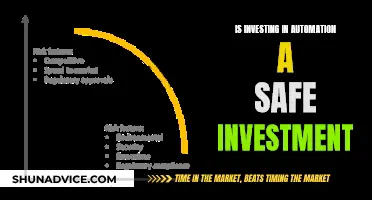
An investment portfolio is a collection of assets that can include stocks, bonds, mutual funds, exchange-traded funds, and real estate. The goal of an investment portfolio is to generate returns over time while managing risk. There is no one-size-fits-all approach to building an investment portfolio, as it depends on various factors such as risk tolerance, financial plans, and evolving needs over time. However, a well-diversified portfolio with a mix of stocks, bonds, and cash is a good way to minimize risk and maximize returns.
When building an investment portfolio, it is essential to consider your financial goals, time horizon, and risk tolerance. Short-term goals are those that need to be accomplished within a year, medium-term goals take one to five years, and long-term goals take more than five years. Your risk tolerance refers to how much loss you are willing to accept in the short term to achieve your goals.
Different types of investment accounts, such as tax-advantaged accounts (IRAs, 401(k)s) and taxable online brokerage accounts, can be used to build an investment portfolio. It is crucial to understand how each type of account works separately and how they interact with each other.
By following these steps and considering your unique circumstances, you can create an investment portfolio that aligns with your goals and risk tolerance.
| Characteristics | Values |
|---|---|
| Risk tolerance | Depends on your financial situation, short- and long-term financial objectives, and tolerance for risk. |
| Time horizon | Depends on your age and financial goals. |
| Investment types | Stocks, bonds, cash, real estate, commodities, mutual funds, exchange-traded funds (ETFs), index funds, alternative investments, etc. |
| Diversification | Don't put all your eggs in one basket. Diversify across asset classes and within asset classes. |
| Asset allocation | Based on your risk tolerance, time horizon, and financial goals. |
| Rebalancing | Monitor and adjust your portfolio regularly. |
What You'll Learn

Risk tolerance and time horizon
As you approach retirement, it is generally recommended to shift your portfolio towards more conservative investments, such as bonds, dividend-paying stocks, and other stable income-generating assets. These assets tend to be less volatile and can help preserve your accumulated wealth while still providing some growth to counteract inflation.
On the other hand, if you are in your 20s, you may want to consider investing more aggressively. You have a longer time horizon, which means you have more time to recover from market downturns and investment mistakes. As such, you may want to allocate a larger portion of your portfolio to stocks, particularly growth stocks or exchange-traded funds, which historically offer higher returns but come with greater risk.
Your risk tolerance and time horizon will also influence your choice of investment accounts. For long-term, retirement-related goals, tax-advantaged accounts like IRAs and 401(k)s are often recommended, as they can accommodate any risk tolerance level. For mid- to long-term goals, taxable online brokerage accounts may be more suitable, as they offer more upside potential than low-risk deposit accounts. Finally, for short-term goals, deposit accounts like CDs, money market accounts, and high-yield savings accounts are generally preferred, as they offer a bit of growth while preserving your capital.
It's important to regularly review and rebalance your portfolio to ensure it remains aligned with your risk tolerance and time horizon. Market fluctuations can cause your asset allocation to drift from your target, so periodic adjustments may be necessary to stay on track. Additionally, life events such as marriage, divorce, parenthood, inheritance, or retirement may also require you to re-evaluate your investment strategy.
Savings and Investments: Strategies for Success in Lean Times
You may want to see also

Asset allocation
Determine Your Risk Tolerance:
Your risk tolerance is a critical factor in deciding how to allocate your assets. It refers to your ability to tolerate investment losses and volatility. Generally, younger investors with a longer investment horizon can handle more risk, while those closer to retirement may prefer a more conservative approach.
Time Horizon:
Consider your investment time horizon, which is the length of time you plan to hold your investments. If you have short-term goals, you'll need the money sooner and may opt for more conservative investments. In contrast, long-term goals provide more flexibility to take on riskier investments.
Diversification:
Diversification is a risk management strategy that involves spreading your investments across various asset classes, sectors, and industries. By not putting "all your eggs in one basket," you reduce the impact of any single investment on your portfolio's performance. Diversification can be achieved by investing in different types of securities, such as stocks, bonds, mutual funds, exchange-traded funds (ETFs), and alternative investments.
There are different asset allocation models to consider, such as income portfolios, balanced portfolios, and growth portfolios. An income portfolio focuses on dividend-paying stocks and coupon-yielding bonds, providing a steady stream of income. A balanced portfolio invests in both stocks and bonds to reduce volatility and is suitable for investors seeking moderate growth. A growth portfolio primarily consists of stocks, aiming for long-term capital appreciation and is suitable for investors with a high-risk tolerance.
Regular Rebalancing:
Over time, the performance of different asset classes will vary, causing your asset allocation to drift from your initial plan. Therefore, it's important to regularly rebalance your portfolio to maintain your desired allocation. This may involve selling some investments that have performed well and investing in other asset classes or adding funds to underweight asset classes.
Age-Based Allocation:
Your age can also guide your asset allocation. A popular rule of thumb is to subtract your age from 100 to determine the percentage of your portfolio allocated to stocks and funds, with the remaining percentage in bonds. For example, a 25-year-old may have an allocation of 75% stocks and 25% bonds, while a 55-year-old may opt for 45% stocks and 55% bonds.
Savings or Investment Plans: Where Should Your Money Go?
You may want to see also

Diversification
A well-diversified financial portfolio should include a range of asset classes such as stocks, bonds, other assets, and cash. The exact composition of your portfolio will depend on your financial goals, risk tolerance, and time horizon.
- Different types of portfolio investments: Get to know the different types of investment tools and the investment risk levels they carry. Stocks are units of ownership in a company and tend to be higher-risk, while bonds are loans to companies or governments and are considered safer. Other assets include real estate, commodities, and alternative investments such as gold. The cash portion of your portfolio should amount to 3-6 months' worth of living expenses as an emergency fund.
- Different funds: Mutual funds, exchange-traded funds (ETFs), and index funds are great ways to introduce diversification to your portfolio. With mutual funds, a fund manager will help invest your capital in a diversified selection of securities. ETFs give you a bundle of securities that can be traded on an exchange, while index funds track the performance of a chosen financial market index.
- Diversify across the same asset classes: Look for assets that are negatively correlated. If one asset declines, the others are likely to remain stable or see a boost in value. For example, stocks and bonds are generally not positively correlated, so when stocks go down, bonds may not necessarily be affected.
- Diversify across different asset classes: If diversifying within a single asset class is a good idea, then diversifying across multiple asset classes is even better. This helps to further mitigate risk and optimise returns. You can use the gains from higher-yield investments to offset any losses from other assets in your portfolio.
- Determine your asset split based on your age: "Lifecycle investing" is a strategy that suggests younger investors with longer financial timelines can take on more risk than older investors. One formula for determining your asset allocation is to subtract your age from 100. For example, if you're 25, your asset allocation would be 75% stocks and funds, and 25% bonds.
Consumption, Savings, and Investment: Understanding Aggregate Behavior
You may want to see also

Emergency funds
The general rule of thumb is to have three to six months' worth of living expenses in your emergency fund. This ensures that you have sufficient funds to cover most unforeseen costs, such as a temporary loss of income or an emergency home repair. By setting aside this money, you reduce the likelihood of having to dip into your long-term savings or investments to cover short-term needs.
Your emergency fund should be kept in a safe and liquid account, such as a savings account or money market account. These types of accounts allow you to access your money quickly when needed, without incurring penalties or fees. They also provide a modest return on your money, which can help keep up with inflation.
It's important to regularly review and adjust your emergency fund as your financial situation changes. For example, if your income increases, you may want to add more to your emergency fund to ensure it continues to cover at least three months' worth of expenses. Similarly, if you experience a significant life event, such as a job loss or an illness, you may need to adjust your emergency fund to cover any additional costs.
While it may be tempting to invest your emergency fund in riskier assets to seek higher returns, it's crucial to prioritise liquidity and stability. Remember, the primary purpose of this fund is to provide a safety net during financial challenges. Therefore, it's best to keep it in low-risk, easily accessible accounts.
Maximizing Small Savings: Smart Strategies for Investing Wisely
You may want to see also

Long-term goals
Tax-Advantaged Retirement Accounts
Retirement accounts like IRAs or workplace retirement plans (e.g. 401(k)s) offer valuable tax benefits. You can deduct contributions from your taxes the year you make them, and after age 59 1/2, you pay income taxes on withdrawals. Alternatively, you can fund a Roth account with money you've already paid taxes on and make tax-free withdrawals. According to Vanguard, a portfolio with 60% stocks and 40% bonds returned an average of 9% annually from 1926 to 2019.
529 Plans
If you're saving for educational expenses, 529 plans are a great option. You can start one before your children are born and invite family members to contribute. You'll benefit from tax-free growth, and your child won't owe taxes as long as the money is used for qualified educational expenses. You can either build your own portfolio or choose a target college start date fund. While you can be relatively aggressive with a 529, you'll probably want to be a little more conservative than with a retirement account.
Taxable Brokerage Account
With a taxable brokerage account, you have control over how and when to invest your money. You can invest in a wide range of asset classes, including individual stocks, cryptocurrencies, or other alternative investments. Most financial experts recommend investing in low-cost index funds, but you can also choose to devote a small part of your portfolio to more speculative investments. Be sure to do your research and keep an eye on account-related and trading fees.
Robo-Advisor Account
If you prefer a more hands-off approach, you can open a robo-advisor account. These accounts use algorithms to choose investments based on your goals, time horizon, and risk tolerance. They typically invest in low-cost exchange-traded funds (ETFs) and can provide a broadly diversified portfolio. The management fee for a robo-advisor is usually around 0.25% annually, plus the cost of any funds in the account.
Individual Stocks
Individual stocks can be a good long-term investment option, especially growth stocks and dividend stocks. Growth stocks are often tech companies that plough their profits back into the business, and while they can be risky, they offer the potential for high returns. Dividend stocks, on the other hand, are typically older, more mature companies that pay out regular cash dividends. Both types of stocks can be purchased at any online broker.
Stock Funds
Stock funds, including ETFs and mutual funds, are a great option if you want to invest in stocks but don't want to spend time analysing individual stocks. They provide diversification and are less risky than buying individual stocks. You can purchase them at any online broker that offers ETFs and mutual funds.
Bond Funds
Bond funds are another way to diversify your portfolio. They contain a variety of bonds from different issuers, providing relatively stable returns with less risk than stocks. You can purchase them at any online broker that offers ETFs and mutual funds.
Real Estate
Investing in real estate can be a good long-term investment, but it requires a significant amount of money to get started and can be actively managed. It can provide high returns if you select a good property and manage it well. You can borrow money from a bank to finance your investment and pay it back over time.
Small-Cap Stocks
Small-cap stocks are stocks of relatively small companies that have the potential to grow quickly. They tend to be more volatile than larger companies, but finding a successful small-cap stock can result in immense returns. You can purchase them at any online broker that offers stock trading.
Invest Your Savings: Safe Strategies for Beginners
You may want to see also
Frequently asked questions
An investment portfolio is a collection of assets and can include investments like stocks, bonds, mutual funds, exchange-traded funds, and real estate.
Your personal risk tolerance, financial situation, short- and long-term financial objectives, and age are all factors that should be considered when creating an investment portfolio.
Some common types of investments include stocks, bonds, mutual funds, exchange-traded funds (ETFs), index funds, and real estate.
Your asset allocation should be based on your financial goals, time horizon, and risk tolerance. For example, if you have short-term financial goals, you may want to consider a more conservative asset allocation, while if you have long-term goals, you can afford to be more aggressive.
It is recommended to review your portfolio at least annually or after significant life events. Rebalancing ensures your investments align with your risk tolerance, investment goals, and time horizon.







